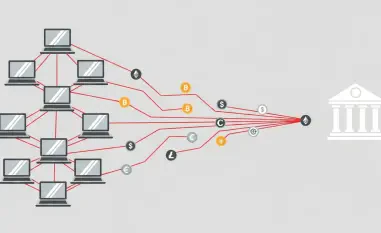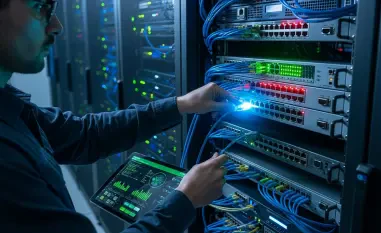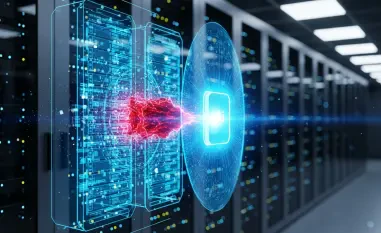The year 2024 was marked by a series of high-profile ransomware attacks that disrupted operations across various sectors. These incidents highlight the evolving threat landscape and the need for robust cybersecurity measures. By analyzing these attacks, we can identify common vulnerabilities and develop strategies to mitigate future risks. The shocking breadth and impact of these attacks have underscored the necessity of proactive defense mechanisms to protect sensitive data and ensure operational continuity in an increasingly digital world.
The Scope of 2024 Ransomware Attacks
Diverse Targets Across Industries
The ransomware attacks of 2024 did not discriminate by industry. From healthcare and manufacturing to educational institutions and sports clubs, no sector was immune. For instance, the Toronto Zoo, an institution not typically associated with critical infrastructure, faced significant disruptions when attackers stole substantial amounts of employees’ personal data dating back to 1989. Similarly, Bologna FC, an Italian soccer club, became a victim when attackers stole sensitive data and published it after the club refused to pay the ransom. These cases highlight that any organization, regardless of its nature, can be targeted by cybercriminals.
Such incidents remind us that an institution’s primary function does not insulate it from cyber threats. The scope of ransomware in 2024 extended further with attacks on entities like Panera Bread, where the food-chain giant experienced a week-long outage due to a ransomware attack affecting IT systems. This broad targeting emphasizes that all sectors must prepare for potential cyber threats. Organizations must recognize their vulnerability and take preemptive measures to shield themselves from the pervasive threat of ransomware, demonstrating that no organization is insignificant in the eyes of cybercriminals.
Operational and Financial Impact
The primary effect of these attacks often involved significant operational disruptions, necessitating manual processes and causing substantial delays and inefficiencies. For example, when Panera Bread’s IT systems, including online ordering and payment systems, were impacted, the chain was forced to continue operations manually, leading to substantial operational challenges. Similarly, the ransomware attack on Stoli Group resulted in such severe disruptions that the company could not submit financial statements, leading to bankruptcy by December. The financial repercussions of ransomware cannot be overstated, extending beyond immediate ransom payments to protracted recovery costs and lost revenue.
Furthermore, UnitedHealth’s ordeal painted an alarming picture of financial devastation. The attack on its subsidiary, Optum Insight and Change Healthcare, crippled over a hundred digital services, causing widespread chaos in the healthcare system. With electronic payments and medical application processing halted, UnitedHealth faced a staggering yearly financial loss of $3.09 billion, including various ransom payments to prevent data leaks by the RansomHub group. Such stories show how ransomware can severely impact operations and finances, making it clear why organizations must invest in comprehensive cybersecurity plans to address these multifaceted threats.
Case Studies of Major Attacks
Healthcare Sector Vulnerabilities
The attacks on UnitedHealth and Ascension revealed the vulnerability of healthcare systems and their critical need for robust cybersecurity measures. The UnitedHealth attack crippled over a hundred Optum digital services, halting electronic payments and medical application processing. This disruption led to chaos throughout the healthcare system, with the medical data of over 100 million patients being stolen. The financial toll was enormous, with $3.09 billion in damages and UnitedHealth being forced to pay $22 million in ransom. This case showcased how ransomware could exploit the healthcare sector’s heavy reliance on digital systems, severely impacting patient care and organizational operations.
On another front, the Ascension healthcare network experienced a ransomware attack that compromised its IT infrastructure, leading to the diversion of emergency patients and manual operations. The Black Basta ransomware group claimed responsibility, stealing data of over 5.6 million individuals. Ascension’s attack highlighted the critical need for healthcare systems to have robust cybersecurity protocols in place. The consequences of such attacks go beyond financial losses, directly impacting patient care and safety. This underscores the importance of healthcare organizations investing in strong cybersecurity measures to protect their digital infrastructure and ensure continuous and secure patient care.
Manufacturing and Tech Industry Challenges
The manufacturing and tech sectors faced significant challenges with ransomware attacks in 2024, demonstrated by incidents involving Hoya Corporation and Casio. Major Japanese optics manufacturer Hoya Corporation fell victim to the Hunters International ransomware group, which disrupted manufacturing plants and ordering systems. The attackers demanded a $10 million ransom and reportedly stole 1.7 million files containing 2TB of data. This attack highlighted the susceptibility of manufacturing industries to ransomware, where disruptions can halt production lines and impair supply chains. Maintaining stringent cybersecurity measures becomes paramount in preventing such high-stakes disruptions.
Similarly, the ransomware attack on Casio, the internationally recognized electronics manufacturer, affected its IT systems and data integrity. The Underground group succeeded in stealing and publishing confidential data, forcing Casio to spend months restoring services. This incident underscored the high risks faced by the tech sector, where data theft and operational disruptions can have far-reaching consequences. The tech industry, which handles vast amounts of sensitive data and relies heavily on interconnected IT systems, must implement comprehensive cybersecurity protocols to protect against such sophisticated cyber threats. These sectors should adopt advanced protective measures and strategies to safeguard their operations.
Lessons from Educational and Judicial Disruptions
Educational Institutions Under Siege
Highline Public Schools in Washington State faced a ransomware attack that caused significant disruption, with all educational activities halted for four days. It took over a month to restore the affected IT infrastructure, highlighting the extensive impact such attacks can have on the educational sector. While the specific data compromised were not disclosed, the district offered precautionary identity monitoring services to those affected. This incident emphasized the vulnerability of educational institutions to ransomware attacks, where the inability to access crucial digital resources can severely impact the learning process.
The attack’s disruption to Highline Public Schools serves as a stark reminder of the importance of implementing robust cybersecurity measures in the educational sector. Educational institutions must adopt strong preventive strategies to safeguard against ransomware, including regular data backups, access controls, and employee training sessions to recognize potential cyber threats. By taking comprehensive measures to secure their digital infrastructure, schools can ensure continuity in education and protect sensitive student and staff data from cybercriminals.
Judicial System Vulnerabilities
The LA County Superior Court, the largest trial court system in the U.S., was also targeted by a ransomware attack in 2024, leading to a temporary suspension of operations. Both external and internal services were impacted, with restoration efforts taking about a week. While specific details about ransom payments or stolen data were not disclosed, the attack caused delays in legal processes, highlighting the judicial system’s vulnerability to ransomware. This case underscores the critical need for comprehensive cybersecurity protocols within judicial systems to protect legal operations and maintain public trust.
The delay in the LA County Superior Court’s operations due to the ransomware attack elucidates the significant challenges faced by judicial systems in ensuring cybersecurity. Interruptions to legal proceedings can have severe implications, affecting timely justice delivery and impacting the broader legal landscape. Judicial institutions must prioritize enhancing their cybersecurity measures, including regular audits, system updates, and employee training, to safeguard their operations against ransomware threats. By ensuring robust cybersecurity protocols, judicial systems can better protect their operations and uphold the integrity of the legal process.
Strategies for Enhanced Cybersecurity
Employee Training and Awareness
Educating employees about the basics of cybersecurity is crucial in preventing attacks originating from human error. Regular training sessions can help staff recognize phishing attempts and other common attack vectors. Employees are often the first line of defense in identifying suspicious activity, and an informed and vigilant workforce can significantly reduce the risk of falling victim to ransomware. By fostering a culture of cybersecurity awareness within the organization, employees can become empowered to take proactive steps in safeguarding their digital environment.
Moreover, employee training should be continuous, adapting to the evolving nature of cyber threats. By staying informed about the latest attack tactics and techniques, employees can better identify and respond to potential security threats. Organizations should also implement simulated phishing exercises to test employee awareness and reinforce the importance of cybersecurity practices. Over time, these efforts can create a more resilient organization capable of thwarting cyber threats through collective vigilance and informed action.
Data Management and Access Control
Implementing appropriate data storage solutions and restricting access to sensitive information can significantly reduce the risk of data breaches. Regular audits and updates to access controls are essential to ensure that only authorized personnel have access to critical data. By creating a secure data management framework, organizations can protect their sensitive information from unauthorized access and potential cyber attacks. Additionally, segmenting data storage and applying strong encryption can further enhance data security and minimize the impact of a breach.
Organizations must also prioritize the use of multi-factor authentication (MFA) to protect user accounts and systems. MFA adds an extra layer of security, making it more challenging for cybercriminals to gain unauthorized access. By regularly reviewing and updating access control policies, organizations can ensure they stay ahead of emerging threats and effectively protect their digital assets. These measures can help build a robust cybersecurity infrastructure that mitigates the risks of data breaches and protects sensitive information from ransomware attacks.
Backup and Recovery Solutions
Regularly backing up data and storing it in isolated environments ensures recovery in the event of an attack. This practice minimizes downtime and helps maintain business continuity. Implementing a robust backup strategy that includes regular backups, data verification, and offsite storage can significantly reduce the impact of a ransomware attack. Organizations should ensure that their backup systems are protected and separate from their primary network to prevent ransomware from compromising backup data.
Moreover, testing the recovery process is crucial to ensure that backups can be restored quickly and effectively in case of an attack. Organizations should conduct regular recovery drills to identify any potential issues and to ensure the backup system’s reliability. By having a well-practiced recovery plan in place, organizations can minimize downtime and quickly restore their operations, thereby mitigating the disruption caused by ransomware attacks.
Advanced Protective Measures
Deploying reliable protection programs on all corporate devices and using Extended Detection and Response (XDR) solutions can help monitor suspicious activity on networks. These measures provide an added layer of security, enabling organizations to detect and respond to threats more swiftly and effectively. XDR solutions integrate multiple security tools and data sources, providing a holistic view of the threat landscape and enabling proactive threat detection and response. By leveraging these advanced protective measures, organizations can enhance their cybersecurity posture and better defend against ransomware attacks.
Organizations should also invest in regular security assessments and vulnerability scans to identify and address potential weaknesses in their systems. Keeping software and systems up to date with the latest security patches is essential to protect against known vulnerabilities. By adopting a proactive approach to cybersecurity, organizations can stay ahead of emerging threats and safeguard their digital infrastructure from ransomware and other cyber attacks.
Outsourcing Security
In 2024, a wave of major ransomware attacks disrupted numerous sectors, demonstrating the growing complexity of cybersecurity threats. These attacks, which affected everything from healthcare to finance, highlighted the urgent need for stronger cybersecurity measures. By examining these incidents, we can pinpoint common vulnerabilities and devise effective strategies to reduce future risks. The widespread nature and significant impact of these attacks have emphasized that proactive defense mechanisms are essential for protecting sensitive information and maintaining operational stability in our increasingly digital age.
As we delve deeper into the specifics of these ransomware incidents, it’s clear that attackers have become more sophisticated, employing advanced tactics to bypass existing security measures. This sophistication calls for organizations to adopt a multi-layered defense approach, including regular software updates, employee training, and the use of advanced threat detection systems.
Moreover, collaboration between private sectors and governmental bodies has become more crucial than ever. Sharing information about threats and vulnerabilities can lead to quicker responses and more efficient mitigation strategies. Overall, the lessons learned from the ransomware attacks of 2024 underscore the necessity of staying vigilant and continually evolving our cybersecurity practices to safeguard our digital infrastructures.













